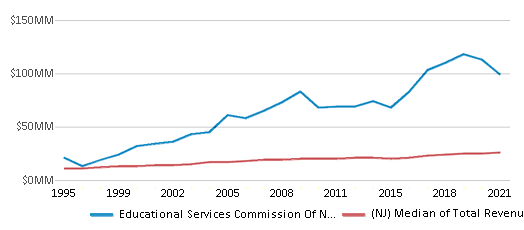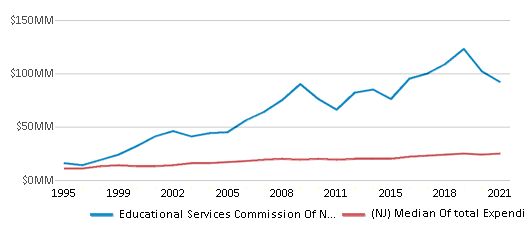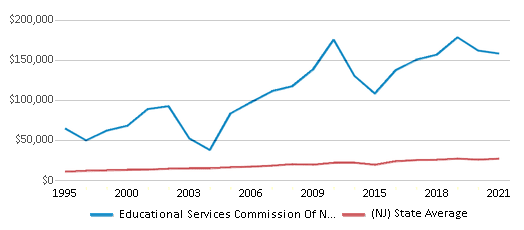Top Rankings
Educational Services Commission Of New Jersey School District ranks among the top 20% of public school district in New Jersey for:
Category
Attribute
Diversity
Most diverse schools (Top 1%)
Student Attention
Lowest student:teacher ratio (Top 1%)
For the 2025 school year, there are 3 public preschools serving 443 students in Educational Services Commission Of New Jersey School District.
Public Preschools in Educational Services Commission Of New Jersey School District have a diversity score of 0.73, which is more than the New Jersey public preschool average of 0.71.
Minority enrollment is 75% of the student body (majority Hispanic), which is more than the New Jersey public preschool average of 64% (majority Hispanic).
Overview
This School District
This State (NJ)
# Schools
6 Schools
924 Schools
# Students
738 Students
368,931 Students
# Teachers
127 Teachers
33,283 Teachers
Student : Teacher Ratio
5:1
5:1
District Rank
The school district's graduation rate of 20-29% has stayed relatively flat over five school years.
Graduation Rate
(10-11)20-29%
86%
Students by Ethnicity:
Diversity Score
0.72
0.71
# American Indian Students
2 Students
901 Students
% American Indian Students
n/a
n/a
# Asian Students
99 Students
30,033 Students
% Asian Students
14%
8%
# Hispanic Students
314 Students
132,928 Students
% Hispanic Students
43%
36%
# Black Students
147 Students
58,834 Students
% Black Students
20%
16%
# White Students
158 Students
132,766 Students
% White Students
21%
36%
# Hawaiian Students
2 Students
790 Students
% Hawaiian Students
n/a
n/a
# Two or more races Students
16 Students
12,631 Students
% of Two or more races Students
2%
4%
Students by Grade:
# Students in PK Grade:
37
59,693
# Students in K Grade:
24
56,070
# Students in 1st Grade:
43
51,032
# Students in 2nd Grade:
44
50,036
# Students in 3rd Grade:
53
42,983
# Students in 4th Grade:
43
37,934
# Students in 5th Grade:
32
29,352
# Students in 6th Grade:
45
15,586
# Students in 7th Grade:
32
11,676
# Students in 8th Grade:
35
11,589
# Students in 9th Grade:
54
663
# Students in 10th Grade:
44
626
# Students in 11th Grade:
50
579
# Students in 12th Grade:
202
1,080
# Ungraded Students:
-
32
District Revenue and Spending
The revenue/student of $134,499 is higher than the state median of $26,931. The school district revenue/student has declined by 21% over four school years.
The school district's spending/student of $124,690 is higher than the state median of $25,828. The school district spending/student has declined by 21% over four school years.
Total Revenue
$99 MM
$36,642 MM

Spending
$92 MM
$35,142 MM

Revenue / Student
$134,499
$26,931

Spending / Student
$124,690
$25,828

Best Educational Services Commission Of New Jersey School District Public Preschools (2025)
School
(Math and Reading Proficiency)
(Math and Reading Proficiency)
Location
Grades
Students
Rank: n/an/a
Academy Learning Center
Special Education School
145 Pergola Avenue
Monroe Township, NJ 08831
(732) 605-9100
Monroe Township, NJ 08831
(732) 605-9100
Grades: PK-12
| 123 students
Rank: n/an/a
Bright Beginnings Learning Center
Special Education School
1660 Stelton Road
Piscataway, NJ 08854
(732) 339-9331
Piscataway, NJ 08854
(732) 339-9331
Grades: PK-4
| 123 students
Rank: n/an/a
Center For Lifelong Learning
Special Education School
333 Cheesequake Rd
Parlin, NJ 08859
(732) 727-3736
Parlin, NJ 08859
(732) 727-3736
Grades: PK-12
| 197 students
Recent Articles

Year-Round Or Traditional Schedule?
Which is more appropriate for your child? A year-round attendance schedule or traditional schedule? We look at the pros and cons.

Why You Should Encourage Your Child to Join a Sports Team
Participating in team sports has a great many benefits for children, there is no doubt. In this article you will learn what those benefits are.

White Students are Now the Minority in U.S. 九游体育s
Increasing birth rates among immigrant families from Asia and Central and South America, combined with lower birth rates among white families, means that for the first time in history, public school students in the United States are majority-minority. This shift in demographics poses difficulties for schools as they work to accommodate children of varying language abilities and socio-economic backgrounds.





